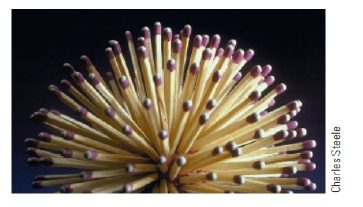
Concept explainers
A mixture of tetraphosphorus trisulfide and powdered glass is in the white tip of strike-anywhere matches. The

The tips of strike-anywhere matches contain tetraphosphorus trisulfide,
which reacts with the oxygen in the air in an exothermic change to inititae
the burning reaction.
Trending nowThis is a popular solution!

Chapter 10 Solutions
Bundle: Introductory Chemistry: An Active Learning Approach, 6th + LMS Integrated for OWLv2, 4 terms (24 months) Printed Access Card
- Q2: Draw all applicable resonance forms for the acetate ion CH3COO. Clearly show all lone pairs, charges, and arrow formalism.arrow_forwardIn the following molecule, indicate the hybridization and shape of the indicated atoms. -z: CH3 CH 3 HO: H3C :Ö: CIarrow_forwardShow mechanism with explanation. don't give Ai generated solutionarrow_forward
- Please Help!!!arrow_forwardQ2: Resonance Forms a) Draw all resonance forms of the molecules. Include curved arrow notation. Label major resonance contributor. SO2 NO3 Page 3 of 4 Chem 0310 Organic Chemistry 1 HW Problem Sets CH3NSO (Thionitromethane, skeleton on the right) H N H3C Sarrow_forwardA 10.00-mL pipet was filled to the mark with distilled water at the lab temperature of 22 oC. The water, delivered to a tared weighing bottle was found to weigh 9.973 g. The density of water at 22 oC is 0.99780 g/mL. Calculate the volume of the pipet in mL. (disregard air displacement for this calculation and record your answer to the proper number of significant digits.)arrow_forward
- Resonance Formsa) Draw all resonance forms of the molecules. Include curved arrow notation. Label majorresonance contributor.arrow_forwardShow work with explanation needed. Don't give Ai generated solutionarrow_forwardf) The unusual molecule [2.2.2] propellane is pictured. 1) Given the bond length and bond angles in the image, what hybridization scheme best describes the carbons marked by the askerisks? 2) What types of orbitals are used in the bond between the two carbons marked by the askerisks? 3) How does this bond compare to an ordinary carbon-carbon bond (which is usually 1.54 Å long)? CH2 1.60Å H2C た C CH2 H2C H₂C * 120° C H2arrow_forward
- Denote the dipole for the indicated bonds in the following molecules. H3C CH3 B F-CCl3 Br-Cl | H3C Si(CH3)3 OH НО. HO H O HO OH vitamin C CH3arrow_forwardQ2: Draw all applicable resonance forms for the acetate ion CH3COO. Clearly show all lone pairs, charges, and arrow formalism.arrow_forwardHow do I calculate the amount of quarks in magnesium?arrow_forward
 ChemistryChemistryISBN:9781305957404Author:Steven S. Zumdahl, Susan A. Zumdahl, Donald J. DeCostePublisher:Cengage Learning
ChemistryChemistryISBN:9781305957404Author:Steven S. Zumdahl, Susan A. Zumdahl, Donald J. DeCostePublisher:Cengage Learning General Chemistry - Standalone book (MindTap Cour...ChemistryISBN:9781305580343Author:Steven D. Gammon, Ebbing, Darrell Ebbing, Steven D., Darrell; Gammon, Darrell Ebbing; Steven D. Gammon, Darrell D.; Gammon, Ebbing; Steven D. Gammon; DarrellPublisher:Cengage Learning
General Chemistry - Standalone book (MindTap Cour...ChemistryISBN:9781305580343Author:Steven D. Gammon, Ebbing, Darrell Ebbing, Steven D., Darrell; Gammon, Darrell Ebbing; Steven D. Gammon, Darrell D.; Gammon, Ebbing; Steven D. Gammon; DarrellPublisher:Cengage Learning Chemistry: An Atoms First ApproachChemistryISBN:9781305079243Author:Steven S. Zumdahl, Susan A. ZumdahlPublisher:Cengage Learning
Chemistry: An Atoms First ApproachChemistryISBN:9781305079243Author:Steven S. Zumdahl, Susan A. ZumdahlPublisher:Cengage Learning Chemistry for Engineering StudentsChemistryISBN:9781337398909Author:Lawrence S. Brown, Tom HolmePublisher:Cengage Learning
Chemistry for Engineering StudentsChemistryISBN:9781337398909Author:Lawrence S. Brown, Tom HolmePublisher:Cengage Learning
 Chemistry: The Molecular ScienceChemistryISBN:9781285199047Author:John W. Moore, Conrad L. StanitskiPublisher:Cengage Learning
Chemistry: The Molecular ScienceChemistryISBN:9781285199047Author:John W. Moore, Conrad L. StanitskiPublisher:Cengage Learning





